
Wilkinsburg is a borough in Allegheny County, Pennsylvania, United States. The borough has a population of 14,349 as of the 2020 census. Wilkinsburg is located as part of the Pittsburgh metropolitan area. The borough was named for John Wilkins Jr., a United States Army officer who served as Quartermaster General of the United States Army from 1796 to 1802.

The North Side is the region of Pittsburgh, Pennsylvania, located to the north of the Allegheny River and the Ohio River.

Downtown Pittsburgh, colloquially referred to as the Golden Triangle, and officially the Central Business District, is the urban downtown center of Pittsburgh, Pennsylvania, United States. It is located at the confluence of the Allegheny River and the Monongahela River whose joining forms the Ohio River. The triangle is bounded by the two rivers.

Allegheny City was a municipality that existed in the U.S. state of Pennsylvania from 1788 until it was annexed by Pittsburgh in 1907. It was located north across the Allegheny River from downtown Pittsburgh, with its southwest border formed by the Ohio River, and is known today as the North Side. The city's waterfront district, along the Allegheny and Ohio rivers, became Pittsburgh's North Shore neighborhood.

The Benedum Center for the Performing Arts is a theater and concert hall located at 237 7th Street in the Cultural District of Pittsburgh, Pennsylvania. Designed by the Philadelphia architectural firm Hoffman-Henon, it was built in 1928 as the Stanley Theatre. The former movie palace was renovated and reopened as the Benedum Center for the Performing Arts in 1987.

Allegheny West is a historic neighborhood in Pittsburgh, Pennsylvania's North Side. The Pittsburgh Historic Review Commission voted in favor of designating the neighborhood as a city historic district in September 1989.
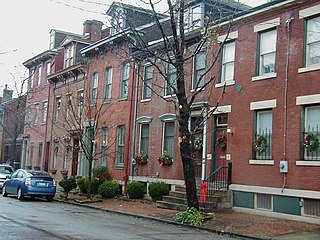
Central Northside is a neighborhood in the North Side of the city of Pittsburgh, Pennsylvania. It has a zip code of 15212, and has representation on Pittsburgh City Council by the council member for District 6. Originally known as "The Buena Vista Tract", it is densely filled with restored row houses, community gardens and tree lined streets and alleyways.

The Mexican War Streets, originally known as the "Buena Vista Tract," is a historic district that is located in the Central Northside neighborhood of Pittsburgh, Pennsylvania, in the United States. The district is densely filled with restored row houses, community gardens, and tree-lined streets and alleyways. The area dates to around the time of the Mexican–American War.

Frederick John Osterling was an American architect, practicing in Pittsburgh from 1888.
The Pittsburgh History & Landmarks Foundation (PHLF) is a nonprofit organization founded in 1964 to support the preservation of historic buildings and neighborhoods in Pittsburgh, Pennsylvania, United States.

Frederick Gustavus Scheibler Jr. was an American architect.

Michael L. Benedum Hall of Engineering is a landmark academic building on the campus of the University of Pittsburgh in Pittsburgh, Pennsylvania, United States. The building was designed in the brutalist style by the architectural firm of Deeter, Ritchey, and Sippel and completed in 1971 at a cost of $15 million. The building was honored with both the Pennsylvania Society American Institute of Architects Honor Award and Distinguished Building Award. It was built with a gift from the Claude Worthington Benedum Foundation and funds from the General State Authority. It stands on a 1.8-acre (7,300 m2) site that was formerly occupied by the National Guard's Logan Armory.
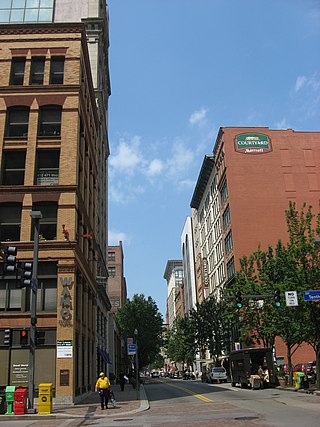
Penn Avenue is a major arterial street in Pittsburgh and Wilkinsburg, in Pennsylvania. Its western terminus lies at Gateway Center in downtown Pittsburgh. For its westernmost ten blocks it serves as the core of the Cultural District with such attractions as Heinz Hall, the Benedum Center and the Byham Theater as well as the David L. Lawrence Convention Center and the Heinz History Center bordering it. Exiting downtown it is the major route through the city's Strip District, Lawrenceville, Bloomfield, Garfield and East Liberty neighborhoods. Its eastern portion exits the city at Wilkinsburg where it continues to exist as Penn Avenue with a numbering system that begins anew using small numbers as it approaches Interstate 376 the "Parkway East". Penn Avenue is about 8.7 miles (14.0 km) long.
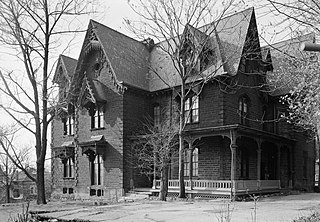
The John F. Singer House is a house in Wilkinsburg, Pennsylvania, United States, an east-side suburb of Pittsburgh. It was built for John F. Singer, who was made wealthy during the American Civil War by supplying the Union Army with iron and steel.
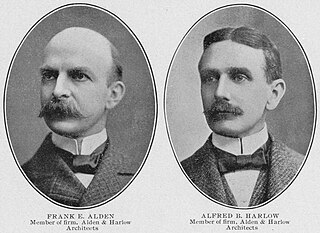
Longfellow, Alden & Harlow, of Boston, Massachusetts, and Pittsburgh, Pennsylvania, was the architectural firm of Alexander Wadsworth Longfellow Jr. (1854–1934), Frank Ellis Alden (1859–1908), and Alfred Branch Harlow (1857–1927). The firm, successors to H. H. Richardson, continued to provide structures in the Romanesque revival style established by Richardson that is often referred to as Richardsonian Romanesque.
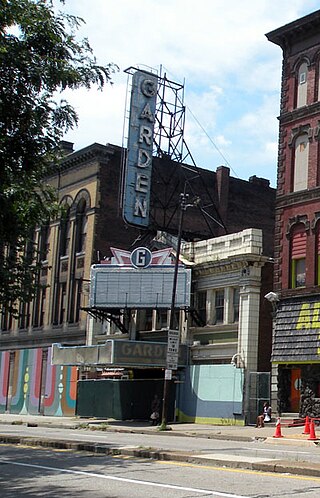
The Garden Theater is a 1,000-seat theater that was built in 1915 at 12 West North Avenue in the Central Northside neighborhood of Pittsburgh, Pennsylvania, USA. Formerly a movie theater, it closed in 2007 and has not been in use much since that time, except for a scene in the movie adaptation of One for the Money starring Katherine Heigl filmed in July 2010. The city of Pittsburgh hopes to revitalize the theater, and it was placed on the List of City of Pittsburgh historic designations by the Pittsburgh City Council on March 25, 2008.

The Pennsylvania Railroad Station-Wilkinsburg is located in Wilkinsburg, Pennsylvania, on Hay Street at the foot of Ross Avenue. The building was completed in 1916 when the railroad embankment through town was elevated above street level to eliminate hazardous grade crossings. The two previous stations had been located three blocks southeast along Wood Street between Franklin and Rebecca Avenues.

The Fourth Avenue Historic District is a historic district in downtown Pittsburgh, Pennsylvania, United States. The district was the center of finance and banks for the city during the decades surrounding the turn of the 20th century.

The Benedum–Trees Building, which is located at 223 Fourth Avenue in downtown Pittsburgh, Pennsylvania, was built in 1905. It was commissioned by Caroline Jones Machesney, the daughter and sole heir of a Pittsburgh banker, making it the first skyscraper in the city ordered by and built for a woman.
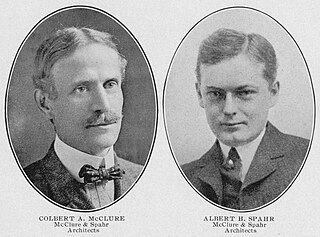
MacClure & Spahr was an architectural firm based in Pittsburgh, Pennsylvania which was active from 1901 to 1922. Several of the firm's buildings have received historic designations. The firm was a partnership between Colbert Anderson MacClure (1879–1912) and Albert Hubbard Spahr (1873–1966), both of whom had studied at the Massachusetts Institute of Technology.



















